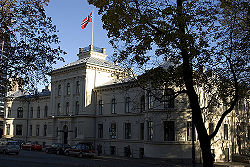
Norwegian National Academy of Fine Arts
Encyclopedia

History
The Art Academy was formerly National Academy of Art (Statens Kunstakademi), an autonomous art academy formed in 1909. The noted Norwegian painter Christian Krogh was one of three professors at the Academy of Art when it was established. The staff additionally included painter Halfdan StrømHalfdan Strøm
Halfdan Strøm was a Norwegian painter. He is represented in the National Gallery of Norway with several paintings. Strøm was a Professor at the Norwegian National Academy of Fine Arts from 1909 to 1935....
and the sculptor Gunnar Utsond (1864–1950).
The Academy was initially organized along the lines of the old master studios. The Academy moved to better premises in the Merchant Building on Drammensveien in central Oslo during 1919 and special drawing office at the rear of the Kunstnernes Hus
Kunstnernes Hus
Kunstnernes Hus is an art gallery in Oslo, Norway. It is Norway's largest gallery under the direction of artists, and has served as a major center for exhibits of Norwegian and international contemporary art. It is also a prominent example of Functionalist architecture and houses the Office for...
in 1930. In 1935, the Danish painter and architect Georg Jacobsen
Georg Jacobsen
Georg Jacobsen was a Danish painter.He studied under Viggo Johansen at the Royal Danish Academy of Fine Arts in Copenhagen from 1906 to 1911. He later spent time in Paris, from 1919 to 1935, as well as Italy and Spain. From 1935 to 1940 he worked at the Norwegian National Academy of Fine Arts...
came to the Academy. From 1935 to 1940, he worked in an extraordinary professorship in art construction and composition teaching. In 1941, the National Assembly called for new arrangements of the academy and added painting and party member Søren Onsager (1878–1946) as a professor.
Oslo National Academy of Art
In the mid-1990s the academy merged with the formerly independent Design, Craft, Stage Arts, and Opera academies to form the Oslo National Academy of Art (Kunsthøgskole i Oslo), the nation's largest arts college. The former Kunstakademiet then became the Faculty of Visual Arts within the KhiO administration organization, but it is still referred to simply as Kunstadademiet, or the Art Academy.In August 2010, all the schools will physically merge into a new building in a former sail factory in Grünerløkka
Grünerløkka
Grünerløkka is a borough of the city of Oslo, Norway. Grünerløkka became part of the city of Oslo in 1858.Grünerløkka was named after Friedrich Grüner who bought a mill in the area from king Christian V of Denmark in 1672 . During the 19th century, Grünerløkka became a working class area...
on the east side of Oslo
Oslo
Oslo is a municipality, as well as the capital and most populous city in Norway. As a municipality , it was established on 1 January 1838. Founded around 1048 by King Harald III of Norway, the city was largely destroyed by fire in 1624. The city was moved under the reign of Denmark–Norway's King...
. It will be one of the largest art academies in Europe. The Kunstakademi has and will have semi-autonomous power of operations, its own quarters and studios as well as its own academic and admissions programs.

